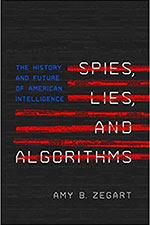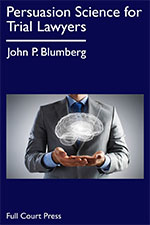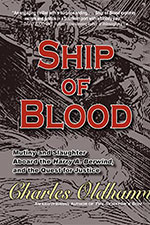
VERDICT: Touchdown!
Spies, Lies, and Algorithms: The History and Future of American Intelligence
By Amy B. Zegart (Princeton, NJ: Princeton Univ. Press, 2022). 405 pgs. $26.96. Order, www.amazon.com.
Reviewed by John Herman
The United States “intelligence community” is a sprawling web of 18 federal agencies and approximately 100,000 people who gather intelligence and analyze foreign people and governments. In Spies, Lies, and Algorithms, Amy Zegart, a political scientist and senior fellow at the Hoover Institution, offers a primer on the world of American national-security intelligence – including its history, its failures and successes, and a window into future challenges and vulnerabilities. Intended for a general audience new to the inner workings of intelligence activities, Zegart’s account is entertaining and thought provoking.
The book can be divided thematically roughly into halves. In the first, Zegart gives the reader the basics about what the intelligence community is and what it does, separating the truth from fictional portrayals of spycraft. The remaining chapters focus on distinct challenges confronting American intelligence. From problems with effective Congressional oversight, to the encroaching blend of military and intelligence operations, to threats posed by changing technology and open-source intelligence, Zegart exposes fundamental tasks for national security, arguing that intelligence “has never been more important, or more challenging.”
Zegart shines in providing a wide-lens view of problems within the intelligence community and how they have manifested into real-world consequences. As an academic, and not a current or former intelligence agent, what Zegart may lack in insider knowledge she makes up for with a disinterested perspective, able to objectively assess structural weaknesses in how the intelligence community operates. In a chapter examining covert actions (for example, drone strikes, propaganda, and cyber sabotage), Zegart goes beyond the political motivations of individual presidents and decision-makers to paint a comprehensive picture of why covert actions are frequently used and why the increasingly blurred line between intelligence and military operations threatens the effectiveness of intelligence gathering. Exploring world events that are often shown to the public through a partisan lens, Zegart’s comprehensive insight presents the bigger picture.
Although the book raises important questions about the future of American intelligence, Zegart does not offer much in the way of solutions for tackling these problems. In each of the final chapters, Zegart identifies structural long-term obstacles inhibiting the ability of intelligence to keep up with national security needs. But concrete solutions are lacking. Ultimately, outlining action steps is outside the scope of what Zegart set out to do. The book’s primary purpose is to introduce readers to the intelligence community, not become policy experts in 275 pages.
Overall, Spies, Lies, and Algorithms is an engaging starting point. Readers will be convinced that all Americans need an interest in intelligence issues. With narrative vignettes used to break up the dense research, Zegart entices nonexpert readers to invest in a subject that is daunting in scope. I recommend it for anyone interested in current national security issues.
John Herman, U.W. 2016, is an assistant state public defender in the Green Bay office.

VERDICT: Touchdown!
Persuasion Science for Trial Lawyers
By John P. Blumberg (Washington D.C.: Full Court Press, 2021). 224 pgs. $99. Order, www.amazon.com.
Reviewed by Nicholas C. Zales
Reading this book will make you a better trial lawyer. John P. Blumberg is an experienced plaintiff’s personal injury attorney who has been involved with more than 200 jury trials. Rather than share anecdotes and stories and describe ways he has prevailed at trial, he links scientific studies on human behavior to how to connect with and win jurors over to your side.
Want to Review a Book?
Please request a book and writing guidelines from the Wisconsin Lawyer managing editor at wislawmag@wisbar.org. Reviewers may keep the book reviewed. Reviews of about 500 words are due within 45 days of receiving the book. Reviews are published, space permitting, in the order received and may be edited for length and clarity.
What does science have to do with the law and jury trials? Science deals with knowledge based on facts learned through experiments and observation that can be replicated anywhere. The author links over 100 social-science studies on human mental processes. How do people process information, what do they do with it, and how do attitudes shape their ultimate choices? That is what this book is all about.
This book discusses every aspect of a jury trial from voir dire to closing arguments. The book has 18 easy-to-read chapters and uses a nice font that leaves plenty of white space on the pages.
Blumberg takes information gleaned from studies on human behavior and applies it to jury trials. In chapter 5, he uses science to discuss how to interest jurors in a subject, how to provide them with the key information they should have without overloading their minds, and how to use graphics, analogies, and metaphors to bring complex topics down to a level that any juror can understand.
Grabbing jurors’ attention is key in a trial, but how to do it? One technique he suggests is based on the “10-10” theory. You have 10 seconds to grab the jurors’ attention and then 10 minutes to explain your theory before their attention wears out. This book is full of tips like this based on scientific studies. Much of the book deals with limitations of human memory. How can a lawyer capture a jury’s interest? How much information can people process? Which forms of communication are most effective? Is the information being provided in a logical way and being presented when the jury is ready to receive it? The author covers these and many other trial-related topics well.
Credibility is key to a trial lawyer’s effectiveness. Without it, no one will be convinced of anything. The book shows how to build and keep credibility by using how jurors process information. Do people have preconceived biases? Do liberals think differently than conservatives? Blumberg answers both questions yes. He uses studies to show how you can convince people not apparently ready to agree with a lawyer’s claims at trial by shaping arguments to what they do believe. Convincing jurors that a cause is just is the essence of a jury trial, but every person on a jury is different. Blumberg shows how studies on human behavior can be used by lawyers to effectively communicate with jurors and prevail at trial.
While some readers might say Blumberg encourages thinking outside the box, I submit he is showing how you can throw away the box and focus on doing the things that will allow you to prevail at trial.
Nicholas C. Zales, Marquette 1989, is a Milwaukee sole practitioner focusing on civil business litigation and is a member of the State Bar’s Board of Governors.

VERDICT: Not For Me, Maybe For You
Ship of Blood: Mutiny and Slaughter Aboard the Harry A. Berwind, and the Quest for Justice
By Charles Oldham (North Chesterfield, VA: Beach Glass Books, 2022). 272 pgs. $28. Order, www.amazon.com.
Reviewed by Sara Butler
Ship of Blood begins by thrusting the reader into the action at the core of this story. Not only through the title, but also through the first few chapters, Charles Oldham sets up the story to create an expectation of a swashbuckling adventure and courtroom drama. The Harry A. Berwind was a four-masted wooden sailing schooner with a steam engine that transported cargo (lumber in this case) and allegedly required low-wage, labor-intensive work under poor working conditions. In October 1905, crew of another vessel found the Harry A. Berwind in distress and sent sailors aboard the Berwind. There, the other vessel’s sailors discovered Henry Scott, whose hands were bound; Robert Sawyer and Arthur Adams; and the bloody body of John Coakley, who was dead. Sawyer and Adams told the arriving sailors that Scott killed the commanding officers and Coakley and threw the officers’ bodies overboard.
The core of Ship of Blood follows the murder trials of Henry Scott, Robert Sawyer, and Arthur Adams – three men of color – who were charged with murdering the four white officers and John Coakley, a Black man. While readers might expect a story with heavy emphasis on Scott, Sawyer, and Adams, the book provides a survey and historical analysis of racial tension in Wilmington, North Carolina. Ship of Blood uses the murder trials as an anchor to guide readers through the town’s post-Civil War history. Oldham provides a detailed, big-picture view of Wilmington and extensive histories of the people who lived there and the significant historical events that occurred there to flesh out the town’s social and political structures at the time of the murder trials of Scott, Adams, and Sawyer.
If you’re looking for a thrilling courtroom drama, Ship of Blood leaves something to be desired. According to the book, original transcripts of the trials still exist, yet few quotations from those transcripts appear, and readers must rely on Oldham’s assessment of the testimony provided by witnesses and the defendants themselves. However, Oldham deftly provides a clear snapshot of Wilmington in the early 1900s and a strong foundation for understanding the people with whom Scott, Sawyer, and Adams came into contact and on whom they had to rely for the administration of justice. Nevertheless, Ship of Blood documents the stories of Scott, Adams, and Sawyer from start to finish with particular emphasis on historical detail.
Sara Butler, U.W. 2021, practices health care law in Milwaukee. She has always enjoyed reading and holds a Bachelor’s degree in English and history.
» Cite this article: 95 Wis. Law. 59-61 (November 2022).
